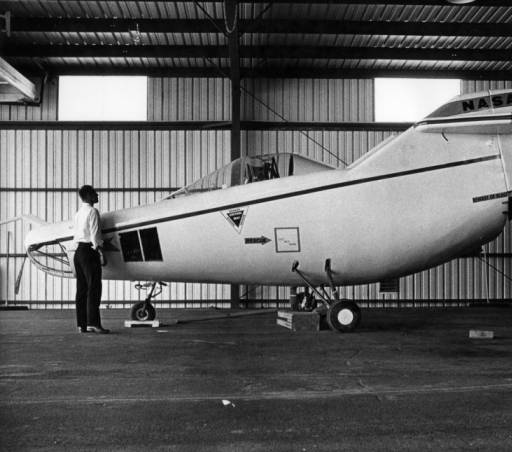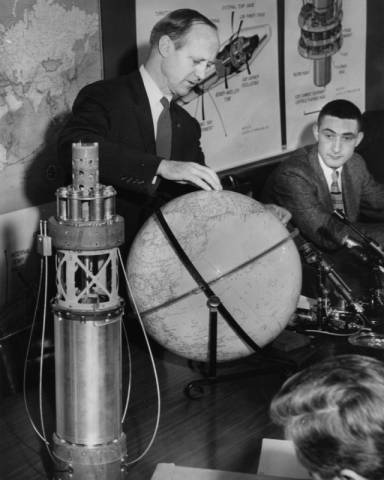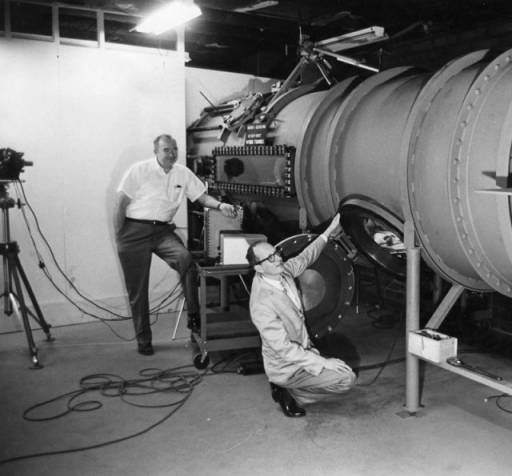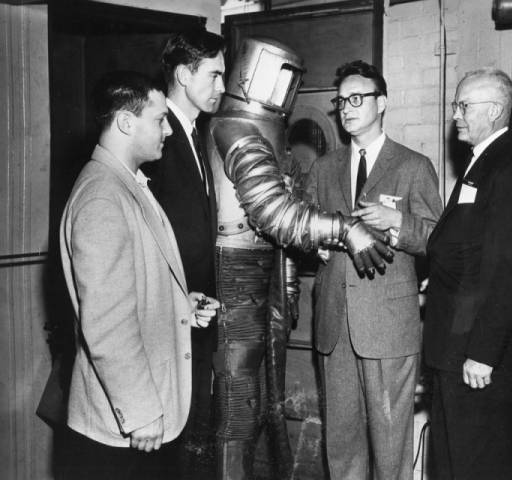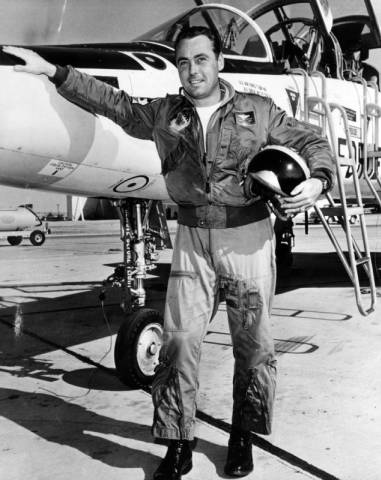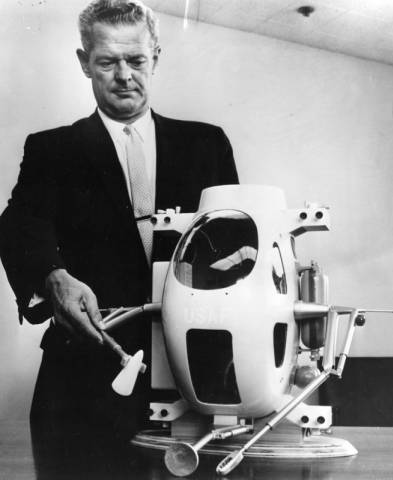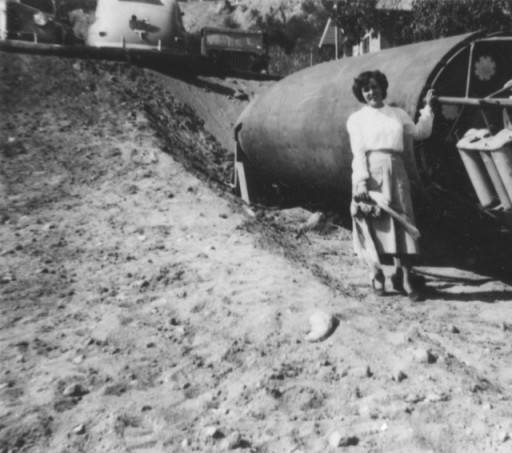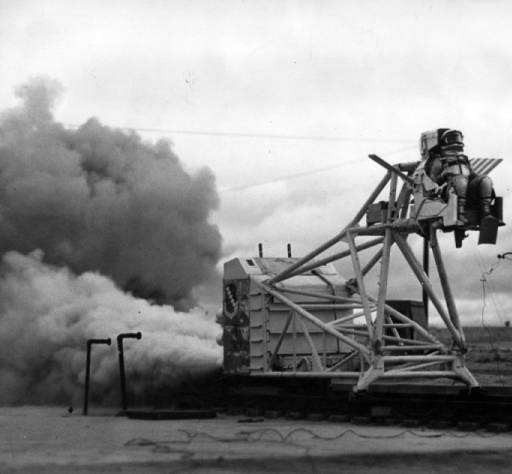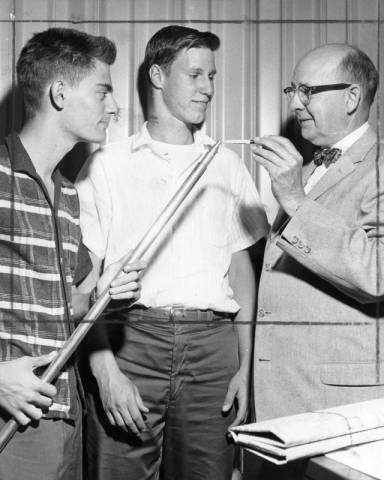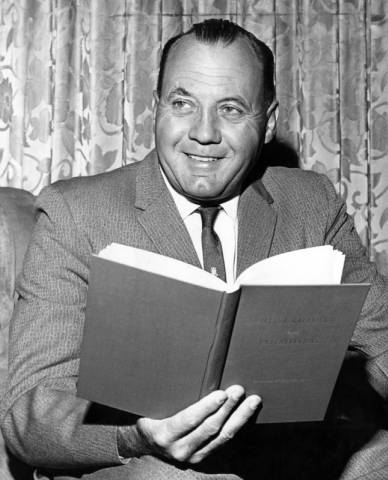Mankind has always looked to the sky and wondered what is up there and how to get there. Southern Californians are no different. Long before Neil Armstrong stepped on the moon in July of 1969, scientists, soldiers, engineers, designers, and space exploration enthusiasts in and around Los Angeles were making plans, asking questions, drawing blueprints, and building machines in order to reach that last frontier. TESSA, the online photo archives of the Los Angeles Public Library, has images showing the commitment, creativity, and curiosity surrounding the space race and Southern California’s involvement in it – in universities, research laboratories, military bases, and basement workshops.
Allyn B. Hazard, Senior Development Engineer at JPL (Jet Propulsion Laboratory in Pasadena, managed by CalTech and owned by NASA), poses in a space suit that he designed. The suit – referred to as the moon suit – was being examined by UCLA biology students.
Valley Times Collection, photo dated February 16, 1961.
After completing their missions, astronauts could glide back into Earth in the “Flying Bathtub” created by the Experimental Aircraft Association, an organization of pilots and engineers dedicated to designing and building the aircraft of the future at their homes in their spare time.
Valley Times Collection, photo taken by George Brich on August 29, 1964.
Dr. William Pickering (standing), Director of JPL for 22 years, discusses a satellite with Albert Hibbs, a renowned mathematician who became known as “the voice of JPL” and who took a break from graduate school to try to beat the casinos at roulette.
Valley Times Collection, photo dated March 5, 1958.
Two scientists at a physics research laboratory in Canoga Park utilize a hypervelocity chamber which simulates conditions experienced in outer space – including temperatures of 80,000 degrees Fahrenheit.
Valley Times Collection, photo taken by Dean Gordon on March 20, 1965.
Emil DeGraeve, Managing Director of Litton Industries’ Space Research Laboratories, explains to Naval Reserve officers the function and fashion of a space suit designed by Litton.
Valley Times Collection, photo dated February 26, 1960.
Three scientists display a model of Explorer I, the first U.S. satellite successfully launched into orbit on January 31, 1958, and discuss the data obtained from this satellite’s foray into space. The panel includes Dr. Henry Richter Jr., JPL’s Group Supervisor of Explorer Design and Development; George Ludwig, a graduate student of Iowa State University who would become a chief research scientist for NASA and JPL; and Phyllis Buwalda, a JPL researcher who determined the surface topography of the moon.
Herald Examiner Collection, photo dated February 13, 1958.
The Dyna-Soar Project was begun in 1960 and was a collaboration between NASA and the United States Air Force. Its mission was to place a man in orbit and then return him to an exact selected spot, with the aircraft available for reuse. In this photo, Air Force Captain William J. Knight stands next to an F-104 Fighter at Edwards Air Force Base. This aircraft was used for the project. No aircraft was ever able to reach the altitudes needed for orbital flight, and Project Dyna-Soar was cancelled in 1963.
Valley Times Collection, photo taken by Jeff Goldwater on April 16, 1962.
A spacecraft engineer from Lockheed-California Co. displays a model of a vehicle with mechanical arms created by the aerospace company. This vehicle could build low orbit satellites and rocket boosters and make repairs in outer space – an invaluable service for solar system exploration.
Valley Times Collection, photo dated August 14, 1960.
Seda Garapedian, an Armenian immigrant, was active in many organizations that assisted Armenian-Americans including the Armenian Allied Arts, the Armenian Film Foundation, and the Armenian Professional Society. A renowned flautist, she taught music in Los Angeles high schools and married Martin Marootian, a pharmacist who spearheaded the class-action suit that forced New York Life to honor insurance policies bought by victims of the Armenian genocide. In this photo, Miss Garapedian poses next to a rocket engine during a tour of JPL (which was building rockets before NASA even existed).
Shades of L.A.: Armenian-American Community, photo taken in 1948.
A mannequin wearing an X-15 flight suit is strapped to a test sled to test equipment operating at speeds of 1,700 mph. The testing took place at Edwards Air Force Base’s speed track in Lancaster, California, and was part of a rocket testing program.
Valley Times Collection, photo dated August 17, 1960.
Miss Gregory of Hollywood, a fashion designer, checks the fit of the space suit she designed for an employee of the Aro Corporation. Miss Gregory also designed the model (left) on which space suits are fitted.
Valley Times Collection, photo taken July 31, 1964.
Robert Stegen of Canoga Electronics in Van Nuys looks at the company’s antennae which (hopefully) will be picking up transmissions from John Glenn’s Mercury satellite which is scheduled to be passing over Southern California shortly after this photo was taken.
Valley Times Collection, photo taken by Jeff Goldwater on February 13, 1962.
Donald May (far right), a chief engineer at Rocketdyne and also President of the Valley Amateur Astrophysical Society, speaks with two members of Reseda High School’s American Rocket Association.
Valley Times Collection, photo dated June 7, 1960.
While attending a meeting of the Valley Amateur Astrophysical Society in Northridge, Daniel W. Fry discusses his contact with an alien space craft which gave him a ride from White Sands, New Mexico, to New York City in less than 30 minutes. Fry, an explosives expert who worked a variety of jobs in the rocketry industry, wrote a book about the incident (The White Sands Incident) and founded an organization (Understanding Inc.) to promote understanding and cooperation among all people – those on Earth and those living on other planets.
Valley Times Collection, photo taken by Alan Hyde on October 30, 1961.


